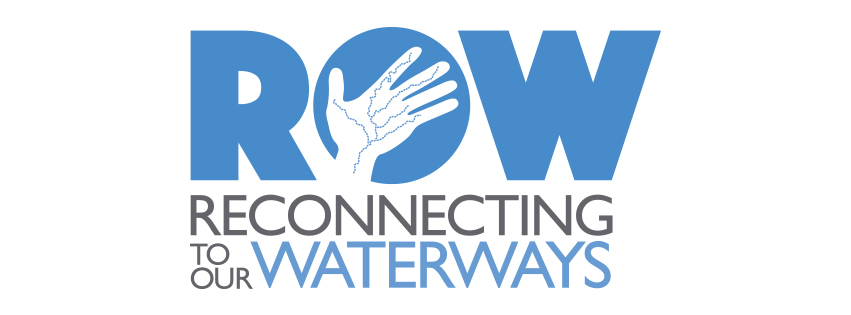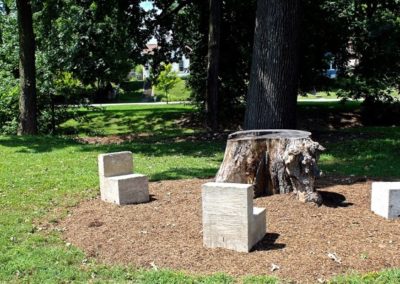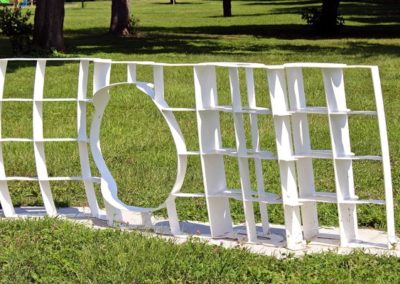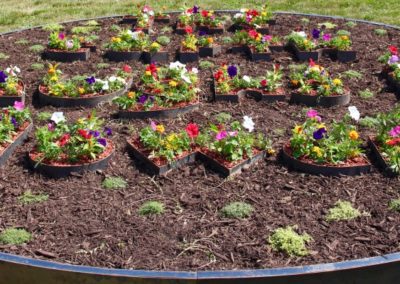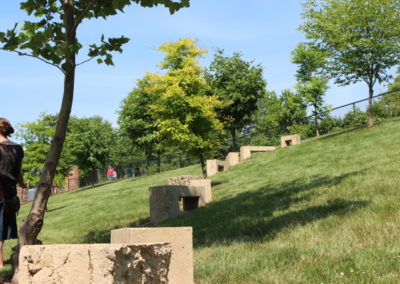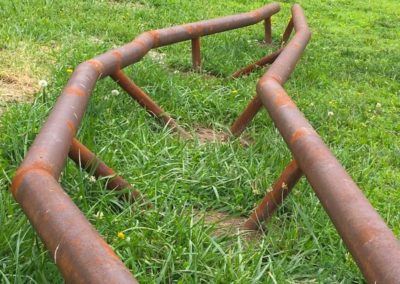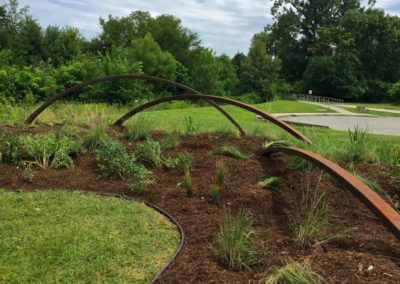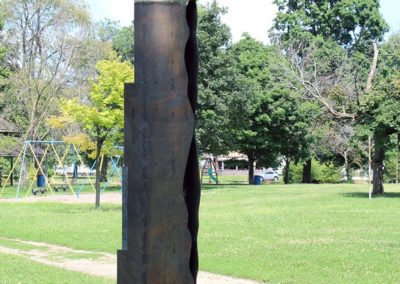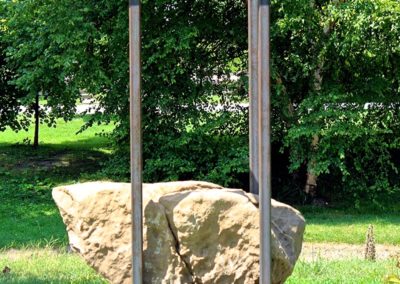With a focus on aesthetics and creative placemaking, the areas bordering Pogue’s Run waterway and trail – including a park, neighborhood, and school – have been transformed. Through a partnership with Williams Creek Management and funded by the Kresge Foundation, Reconnecting to Our Waterways worked with local artists and community members to create three rest stops – places that give people a chance to pause and see the power of art and the beauty of Pogue’s Run.
Pogue’s Run. You’ve ridden by it. You’ve driven over it. You might live near it. However, chances are you’ve also had no idea you were by one of Indianapolis’ six main waterways. Pogue’s Run waterway starts in the eastside of Indianapolis and winds its way to the heart of the city, where it is beneath some of the most recognizable places in Indianapolis, such as Lucas Oil Stadium and Banker’s Life Fieldhouse. The story of Pogue’s Run, in particular the waterway’s namesake George Pogue, has always been one of mystery, starting with the disappearance of Pogue in the early 1800s and the later disappearance of the waterway through downtown as a result of flooding and city development. In more recent years, residents and organizations alike have taken steps to enhance, develop and uncover the waterways that run through Indianapolis, including the forgotten Pogue’s Run waterway. At the helm of this revitalization movement is Reconnecting to Our Waterways (ROW), a grassroots initiative focused on generating new opportunities for neighborhoods and highlighting the beauty of the city’s waterways. Through an integrated approach focused on six elements – such as economics, well-being and education – ROW looks for projects that support a holistic solution to improving the waterways. Aesthetics, an element that concentrates on using sensory engagement to infuse art and natural beauty into each waterway community, was the perfect match for their work with Pogue’s Run. Williams Creek serves as co-project manager for the Pogue’s Run waterway as part of the Reconnecting to Our Waterways (ROW) initiative in Indianapolis, IN. The efforts of ROW, community members, organizations, technical leaders, and businesses look to enhance the quality and connectivity of our waterways through art, nature and beauty. Pogue’s Run travels through neighborhoods and past schools and parks, creating a common thread for the community which has lots of untapped potential to bring people together with nature, neighbors and art. To unlock these possibilities and bring new energy to the surrounding areas, ROW, led by the Pogue’s Run Committee and their project manager Williams Creek, funded local artists and organizations to develop three spots for engagement and reflection – a grant project called “Pogue’s Run Rest Stops: A Reason to Pause.” Funded by the Kresge Foundation, these rest stops – one in the Cottage Home neighborhood, one in Spades Park, and one at Paramount School of Excellence – focus on the development of the waterway and community through sculptural, programmatic and educational art.
“We looked at greenspaces along Pogue’s Run which were already being utilized to capitalize on what was already going on, rather than invent or create something completely new. We also have done extensive public outreach, meeting with individual neighborhood groups several times, Indy Parks, the City Department of Public Works and community stakeholders to ensure long term sustainability of the rest stops.”
Sarah Evans, Williams Creek
In order to have art, one needs an artist, or in this case, multiple artists. Enter Eric Nordgulen, Cottage Home resident, local professional artist and instructor at Herron School of Art and Design. Originally approached by his neighborhood association interested in installing art in their neighborhood, Nordgulen believed a project like this could take place beyond just Cottage Home and involve more than just his own art. Once the grant from ROW was awarded to the Pogue’s Run Waterway Committee’s proposal to connect the waterway to the neighborhoods through art and the rest stops, Nordgulen and the committee got to work. To develop the artwork for each location, Nordgulen, who has done multiple public projects in the city, was determined to not only showcase local professional artists, but also involve the students at Herron and give them an opportunity to see the process of creating and developing public art. In order to choose the artists that would be represented, Nordgulen and fellow Herron instructors Greg Hull and Emily Stergar held a competition where students needed to create models that related to the themes of ROW, such as environmental issues, community development and history. Each student visited the three designated areas, designed their pieces and then presented to various local organizations to receive feedback on their ideas. From those initial 14, six students were chosen to develop their art for installation along the banks of Pogue’s Run.
“When it comes to the history of Pogue’s Run and the waterways in general, we take them for granted. Then art comes along, and we start to think of the area differently, think of the waterway differently. I think it’s very important, if even for a short time, to think about our surroundings with a new perspective.”
Eric Nordgulen, Herron School of Art and Design
Each artist developed their own perspective on Pogue’s Run; each artist considered how to communicate what they felt or noticed about the creek; each artist paused by Pogue’s Run in an effort to encourage the public to do the same. As evident by the pieces installed, the waterway can mean different things to different people – what’s important is that a community has the chance to interact with it as it chooses. Designating each rest stop is Nordgulen’s own installation, Watermark, which serves as signage and a hub of information. Derived from aerial maps and the flow of the city’s rivers, creeks and blueprint, the Watermark contains shelves and space for the neighborhood to highlight facts about the area, show work from another local artist or encourage exploration. The rotating displays will hopefully inspire an ongoing education of the surrounding community. Besides the Watermark, artist and instructor Greg Hull’s piece, Stone Lantern, is also present at each rest stop. Where the Watermark focuses on a connection between the community and the visitor, Stone Lantern looks at the relationship between the visitor and the waterway itself. Featuring an interesting combination of nature and technology, Hull’s piece includes a barcode where a visitor can scan it with their smartphone and hear a recording of the water of Pogue’s Run, providing an opportunity for reflection and connection to the creek.
The final phase of art installations will include work from local students from Arsenal Tech. Nordgulen reached out to two contacts at the eastside high school to share the idea of getting the art students involved with the neighborhood and rest stops project. Come October, the goal is to have a piece at both the Cottage Home and Spades Park locations. As Nordgulen points out, the partnership is extremely beneficial for the high school students because it gives them an opportunity to connect with college students and local professional artists, as well as see a future of art in their own lives. “I think of art as a tool that people use to better understand their relationship with their surroundings,” Nordgulen said. “We triangulate between ourselves, art and what we’re aware of. Art then gives us a chance to rethink our environment and our thoughts on issues and to understand things a little differently or a little better.” Perhaps moving forward that can be a goal of neighborhoods, students and individuals: to understand ourselves, our city and our waterways a little differently or a little better. Maybe then the power of community, the influence of art and the beauty of Pogue’s Run won’t be such a mystery. ROW has brought together residents, non-profits and for-profit organizations, and city officials and funders into the neighborhood. Through the collective impact, it has improved access to resources and attention to issues that had gone unseen for years. ROW is focused on reclaiming the benefits of Indianapolis’ waterways and surrounding communities so everyone has access to art, nature, and beauty every day.
